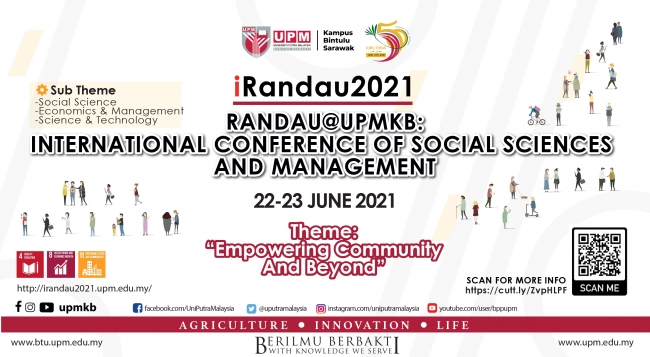GUIDELINES - ABSTRACT, POSTER & ORAL
GUIDELINES - ABSTRACT, ORAL, VIDEO, POSTER
Abstract Submission Guidelines
In conjunction with the iRandau 2021 theme, papers of relevant topics within the conference theme are invited for oral/video/poster presentations. Authors are requested to submit an abstract not exceeding 300 words in English language only. The abstract must include the title, author(s) and affiliations, introduction, materials and methods, results and discussion, conclusion, and references. Please download the abstract template and follow the format carefully.
Once you have prepared your abstract according to the guidelines, submit your abstract to
http://cutt.ly/ZvpHLPF or email to irandau2021@upm.edu.my
The deadline for abstract submission is on the 21st May 2021.
The deadline for full text paper submission is on the 8th June 2021.
ORAL PRESENTATION
For live oral presenters, you may choose to present from the venue (UPMKB) or via online. Each speaker shall be given 10 minutes for oral presentation and 5 minutes for Q & A. All presentation slides shall be prepared in Microsoft Power Point (ppt.) format. Presentation slides must be submitted to the organizing committee by email to irandau2021@upm.edu.my a day before iRANDAU2021 commences, or via your personal thumb drive at the registration counter/presentation venue half an hour before your session.
VIDEO PRESENTATON
For online video presenters, the duration of the video must be 10 minutes. The recommended file formats:
-Video presentations: MP4, MPEG4, MOV, WMV, FLV, AVI, etc
- Size: 1280x720 – HD
The presenter is advised to attend the conference online during their slot for Q & A session. Please submit your video to irandau2021@upm.edu.my before 3rd June 2021.
POSTER PRESENTATION
For poster presenters, please submit the softcopy of your poster to irandau2021@upm.edu.my before 3rd June 2021. Posters will be uploaded in the website and displayed during the event. Below is the Poster Guidelines AFTER ACCEPTANCE.
1. Size
Poster should be printed in A1 size (59.4 cm width × 84.1 cm height) in portrait orientation. There are many options for software. The most common choice is Microsoft PowerPoint. Others include InDesign, Photoshop, etc.
2. Content
There are no hard-and-fast rules for the sections in a poster. Here is a suggested list:
- Title (with names of authors and affiliations)
-Keep the poster title to fewer than 12 words. Put important words first. Leave out unnecessary words.
b. Introduction/Objectives/Aims/Problem/Goal
- Give context for your work by stating what is already known about the topic. Then show how your question fits into that framework and seeks to expand or explain some aspect of it.
c. Conceptual Framework/Methodology
- Keep the methods section minimal. Consider using a graphic of the steps or a bulleted list.
d. Results/Findings
- Organize the data. A table is much better than a list but use a bulleted list if appropriate. Do not forget to put units on everything. Results sections typically have very little text.
e. Conclusion
- Explicitly state what you found in your research. Note its significance. Focus on the larger picture. Directly address the question you proposed in the introduction, using the same terminology and phrasing. Graphs work particularly well here. Recommend how your results might be used and explain how they have added to the knowledge base in your field. Indicate how they answer a vexing problem; evaluate how well the results answered your question; show how they lead to other areas of study; give an idea of what new questions they open. Never indicate that further study is required unless you have a specific plan for the next step.
f. Acknowledgements
- Acknowledge the people who contributed directly to the work. Thank your adviser. Acknowledge any funding you received. If you worked off-campus, acknowledge that group.
g. Contact information (including QR code)
- A QR (Quick Response) code is often put in the lower right-hand corner of the poster with other contact information. You do not have to use a QR code, but it adds a level of professionalism to your work.
*Author(s) may also add Photos and QR codes on the poster.
3. Layout, colours and fonts
Authors may customize the font type, text, and background colours. The size of the font should be at least 20pt. Dark text on a light background is easiest to read. If you have a very dark background, use large, bold white text. Avoid color-on-color, especially bright hues. Keep backgrounds simple. While it is possible to create graphs and charts directly within PowerPoint, the process is restrictive and quirky. Use Excel to create graphs and charts.
4. Suggested font size
- Title Bar – 42-48 points, bold and capitalized research topic
- Header – 30-36 points and bold
- Content – at least 20 points
5. Kindly provide clear illustration and visual materials (photographs/figure, charts, maps, graphs, etc.) for an enhanced and effective poster presentation.

